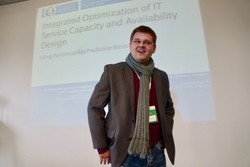VLBA Lab at the International Conference on Wirtschaftsinformatik 2017 in St. Gallen

For the 13th time in succession, the german-speaking business informatics community gathered at the International Conference on Wirtschaftsinformatik (WI) which took place from 12 to 15 February 2017 in St. Gallen, Switzerland with more than 750 participants. 13 scientific tracks and sessions allowed for a presentation of about 100 selected research projects covering the whole spectrum of methods and applications in the field of business informatics in Germany. Topics like digitization, hybrid value creation, IT management, knowledge management and analytics are just a few examples to be mentioned here.
The Very Large Business Application Lab was present for the third time in succession providing a selected research contribution. Therein, the authors around Dr. Sascha Bosse, Hendrik Müller and Professor Klaus Turowski pursued the question of how to optimize the availability and capacity design for IT systems in an integrated manner. Dr. Sascha Bosse presented the research findings which can be summarized as follows:Traditionally, a system’s capacity for the required performance is assessed (“sizing”) prior to, for instance, the definition of redundancy mechanisms in order to meet the availability requirements of a system. The difficulty here is that possible failures during the process of sizing are not considered, which means that the future (real) performance of the system is overestimated. On the other hand, optimization approaches in availability planning seek to minimize the likelihood of failures. This usually results in rather conservative estimates regarding the system quality, so that possible cost savings cannot be identified.The first two of these approaches may be considered in the service design stage. However, the success of fault prevention is limited due to the fact that faults can never be excluded completely. Therefore, fault tolerance mechanisms are a powerful but expensive approach to increase availability.
By using so called performability models (a portmanteau comprising the words performance and availability), these problems can be addressed. Within the framework of the research project, a simulation model based on Petri nets and queuing models was thus developed predicting the effects of additional capacity (active redundancy) and passive redundant systems on the performance and availability of a system. By using meta heuristics, such as genetic algorithms, the costs of a system design could be minimized in compliance with the respective requirements of performance and availability.
The investigations presented in this article highlight the fact that integrated optimization may lead to considerable cost savings without negatively affecting system quality. The analyzed scenario of an SAP system for sales responsibilities with an integration to customer relationship management as well as accounting and productions systems, revealed potential savings up to 30% in acquisition and operating costs concerning three years of systems operation.



